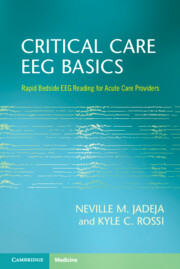101 results
Recurrent Cortical Encephalitis-Like MRI Lesion in European Descent Patient with Neuronal Intranuclear Inclusion Disease
-
- Journal:
- Canadian Journal of Neurological Sciences , First View
- Published online by Cambridge University Press:
- 04 March 2025, pp. 1-4
-
- Article
- Export citation
Impact of albendazole treatment on the symptom profile of neurocysticercosis patients 14–16 years following diagnosis
-
- Journal:
- Parasitology , First View
- Published online by Cambridge University Press:
- 24 February 2025, pp. 1-9
-
- Article
-
- You have access
- Open access
- HTML
- Export citation
New Diagnosis of Ornithine Transcarbamylase Deficiency in a 71-Year-Old Man
-
- Journal:
- Canadian Journal of Neurological Sciences , First View
- Published online by Cambridge University Press:
- 24 February 2025, pp. 1-7
-
- Article
-
- You have access
- Open access
- HTML
- Export citation
Chapter 3 - Sleep-Related Comorbidities in Women with Epilepsy
-
-
- Book:
- Women with Epilepsy
- Published online:
- 19 December 2024
- Print publication:
- 02 January 2025, pp 46-63
-
- Chapter
- Export citation
Chapter 17 - Epilepsy
-
-
- Book:
- The Frith Prescribing Guidelines for People with Intellectual Disability
- Published online:
- 07 November 2024
- Print publication:
- 21 November 2024, pp 238-253
-
- Chapter
- Export citation
Evidencing the challenges of care delivery for people with intellectual disability and epilepsy in England by using the Step Together toolkit
-
- Journal:
- BJPsych Open / Volume 10 / Issue 6 / November 2024
- Published online by Cambridge University Press:
- 28 October 2024, e186
-
- Article
-
- You have access
- Open access
- HTML
- Export citation
Low Yield of Routine Cerebrospinal Fluid Analysis to Assess for An Autoimmune Etiology in Patients with Chronic Seizures of Unknown Cause
-
- Journal:
- Canadian Journal of Neurological Sciences / Volume 52 / Issue 2 / March 2025
- Published online by Cambridge University Press:
- 04 June 2024, pp. 327-330
-
- Article
-
- You have access
- Open access
- HTML
- Export citation
Management of Seizures and Epilepsy in Patients with Autoimmune Encephalitis
-
- Journal:
- Canadian Journal of Neurological Sciences / Volume 52 / Issue 2 / March 2025
- Published online by Cambridge University Press:
- 02 May 2024, p. 340
-
- Article
- Export citation
The relationship between clinical presentation and the nature of care in adults with intellectual disability and epilepsy – national comparative cohort study
-
- Journal:
- BJPsych Open / Volume 10 / Issue 3 / May 2024
- Published online by Cambridge University Press:
- 30 April 2024, e94
-
- Article
-
- You have access
- Open access
- HTML
- Export citation
Response to: Management of Seizures and Epilepsy in Patients with Autoimmune Encephalitis
-
- Journal:
- Canadian Journal of Neurological Sciences / Volume 52 / Issue 2 / March 2025
- Published online by Cambridge University Press:
- 29 April 2024, pp. 341-342
-
- Article
- Export citation
Chapter 6.5 - Functional Neurological Disorder
-
-
- Book:
- Seminars in General Adult Psychiatry
- Published online:
- 04 April 2024
- Print publication:
- 18 April 2024, pp 366-386
-
- Chapter
- Export citation

Management of Seizures in Neurosurgical Practice
-
- Published online:
- 13 April 2024
- Print publication:
- 09 May 2024
-
- Element
- Export citation
Chapter 12 - Seizure Mimics
- from Part II - Case-Based Approach to Specific Conditions
-
- Book:
- Critical Care EEG Basics
- Published online:
- 22 February 2024
- Print publication:
- 29 February 2024, pp 169-181
-
- Chapter
- Export citation
Chapter 11 - Seizures and Epileptiform Discharges
- from Part II - Case-Based Approach to Specific Conditions
-
- Book:
- Critical Care EEG Basics
- Published online:
- 22 February 2024
- Print publication:
- 29 February 2024, pp 160-168
-
- Chapter
- Export citation

Critical Care EEG Basics
- Rapid Bedside EEG Reading for Acute Care Providers
-
- Published online:
- 22 February 2024
- Print publication:
- 29 February 2024
8 - Lost in the Fog of Alzheimer’s
-
- Book:
- Dispatches from the Land of Alzheimer's
- Published online:
- 19 January 2024
- Print publication:
- 22 February 2024, pp 34-37
-
- Chapter
- Export citation
Epilepsy Versus High Risk of Epilepsy in Autoimmune Encephalitis: An Essential Distinction
-
- Journal:
- Canadian Journal of Neurological Sciences / Volume 51 / Issue 6 / November 2024
- Published online by Cambridge University Press:
- 05 January 2024, pp. 755-757
-
- Article
- Export citation
Pangolin seizures in Nepal indicate priority areas for conservation interventions
-
- Article
-
- You have access
- Open access
- HTML
- Export citation
Dynamic impedance is correlated with static impedance and seizure quality parameters in bifrontal electroconvulsive therapy
-
- Journal:
- Acta Neuropsychiatrica / Volume 35 / Issue 3 / June 2023
- Published online by Cambridge University Press:
- 21 February 2023, pp. 177-185
-
- Article
-
- You have access
- Open access
- HTML
- Export citation
Neurological involvement in hospitalized children with SARS-CoV-2 infection: a multinational study
- Part of
-
- Journal:
- Canadian Journal of Neurological Sciences / Volume 51 / Issue 1 / January 2024
- Published online by Cambridge University Press:
- 04 January 2023, pp. 40-49
-
- Article
-
- You have access
- Open access
- HTML
- Export citation

